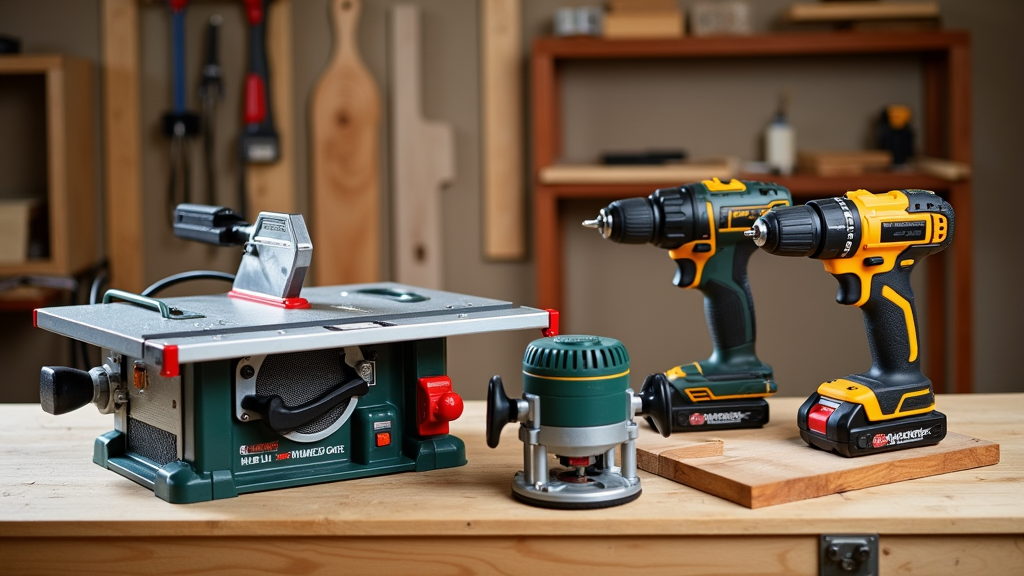If you’re getting into woodworking, you’ll quickly notice there’s a huge range of power tools out there. The basics are great, but taking your tool kit up a notch seriously improves what you can make and how you work. Building furniture, cabinetry, or even small projects gets much easier and safer when you’ve got some reliable power tools in your shop. I’ve put together an all-in-one guide covering the top power tools every woodworker should own, some tips for choosing brands, and answers to a few common questions about woodworking tools.

Essential Power Tools for Woodworkers
Starting a woodworking adventure without power tools usually means a lot more sweat and slower progress. Power tools don’t just speed things up; they also give you cleaner cuts, more accuracy, and a smoother workflow. Most woodworkers eventually build up a collection, but some tools get way more use than others. Here are the main ones that really belong in every shop:
- Table Saw: This is practically the center of any woodworking shop. Super useful for making straight, long cuts (called rip cuts) and repetitive crosscuts.
- Power Drill/Driver: Used for boring holes and driving screws. Cordless drills are really popular since you can move around freely, but corded models usually have more power.
- Miter Saw: Great for making crosscuts, angle cuts, and quickly chopping boards to length.
- Router: Opens up a lot of options for adding decorative edges, shaping, or cutting grooves in wood. Plunge routers and fixedbase routers each have their advantages.
- Jigsaw: Best tool for curvy or complex cuts. Much easier than trying to cut curves by hand with a coping saw.
- Random Orbital Sander: Sanding by hand can get old fast. These sanders are fast and leave a smooth finish without visible sanding marks.
- Circular Saw: It’s handy when you need a portable tool to break down sheet goods, trim boards, or work away from your main shop space.
- Band Saw: Very useful for making curved cuts, resawing thick boards, or cutting small, delicate parts. If you’re into furniture making, a bandsaw really helps.
- Drill Press: Gives you accuracy for boring perfectly straight or angled holes. Especially helpful if you’re making furniture with lots of dowel joinery or need repeatable holes.
- Planer: This tool shaves wood down so boards are the same thickness. It can help turn cheap roughcut wood into nice, usable boards.
- Jointer: If you’re buying rough lumber, a jointer makes faces and edges flat. Super important for getting boards to fit tightly together in panel glueups.
- Compound Sliding Miter Saw: Lets you tackle more complex angle and bevel cuts, and the slide feature means you can cut wider boards too.
Most beginners start with just a few of these, but as projects get bigger, expanding your tool lineup only gives you more flexibility and control. Over time, this investment grows your skill set and allows for more ambitious builds.
Quick Tips for Choosing the Right Power Tool Brands
It’s easy to get overwhelmed by brand choices when shopping for tools. Some folks are loyal to one brand, while others like mixing and matching for the best value or features. In woodworking, brands like Dewalt, Makita, Bosch, and Milwaukee are super popular because of their durability and overall performance. Festool is a premium choice, often found in professional shops, with some seriously precise and dustfriendly gear.
If you’re just starting, picking tools from the same brand family, especially for cordless options, can be smart. Most brands use proprietary batteries, so staying with one brand means you can swap batteries across your tools. That said, don’t feel locked in; sometimes a specific tool is worth mixing brands for, especially if it solves a specific need or fits your budget better. Thorough research helps buyers make informed decisions when spending big money on power equipment. It’s a good idea to ask around local woodworking groups or shop owners about their experiences, since real-world feedback often goes deeper than marketing claims.
Building Your First Woodworking Power Tool Set
If you’re looking for a rough checklist before you hit the store, here’s a starting lineup that covers just about anything a furniture maker or DIYer would want to tackle. Here are twelve tools that seriously change the game, especially for anyone focused on furniture:
- Table Saw
- Miter Saw (Compound Sliding if possible)
- Power Drill/Driver
- Random Orbital Sander
- Router (preferably with both fixed and plunge bases)
- Jigsaw
- Circular Saw
- Band Saw
- Drill Press
- Planer
- Jointer
- Shop Vacuum (for dust control)
This set gives you everything you need for breaking down lumber, making clean, straight cuts, shaping edges, cutting joinery, smoothing surfaces, and keeping your shop safer and tidier. Dust collection isn’t always seen as a “power tool” at first glance, but it’s really important for both your health and the quality of your projects. Even a basic shop vacuum setup can step up air quality and help you clean up quickly after a long session in the workshop.
Questions to Ask Before Buying Power Tools for Woodworking
No matter how tempting a flashy new tool might be, asking the right questions before you buy saves a lot of headaches and cash down the line. Here are a few things I always keep in mind:
- What types of projects am I doing most? If you’re making lots of cabinets, a track saw and drill/driver combo get used more than a bandsaw might.
- How much space do I have? Big stationary tools are awesome but sometimes just won’t fit.
- Am I using rough lumber? This means a planer and jointer become really useful, versus store-bought processed wood.
- What is my budget and can I wait for quality? You’re usually better off saving for a solid tool than grabbing the cheapest version right away.
Checking out reviews and watching tool demonstrations online can also help when you’re comparing models side by side. Some brands might offer features that really click with your style or specific jobs, so it’s worth spending some time before making that purchase. And don’t be shy about asking other woodworkers for honest opinions—they’ve often made plenty of mistakes you can learn from.
Common Hurdles for New Woodworkers (and How to Handle Them)
Learning to use power tools isn’t always smooth sailing. Safety is always up there for most woodworkers, but so are things like workshop space and dealing with dust. Here are a few tips to make your experience safer and more enjoyable:
- Safety Gear: Always use safety glasses, ear protection, and (for sanding or cutting MDF) a dust mask. No project is worth risking your hearing, sight, or lungs.
- Practice makes better: It’s normal for cuts and joinery to be wonky at first. Practicing on scrap wood helps you build skills without wasting good material.
- Dust Control: Shop vacuums or dust extractors really make a difference in your workspace air quality. Some bigger tools can be hooked directly to vacuums.
- Keep it sharp: Dull blades or bits are more dangerous and will also ruin your wood. Blade and bit maintenance is a big deal. Keeping an eye on sharpness pays off in both results and safety.
- Plan ahead: Measuring twice and only cutting once is a classic rule for a reason. Rushing leads to wasted material and mistakes, and can even be risky. Sketch your project and organize your workflow so you’re less likely to skip steps or lose track.
Learning these basics goes a long way in making woodworking more enjoyable and a lot safer. Take the time to build those good habits and you’ll reap the rewards down the road.
Answers to Frequent Woodworking Power Tool Questions
What tools does every woodworker need?
Almost every woodworker needs a reliable saw (like a table or circular saw), drill/driver, sander, and router. These tools cover the essentials like cutting, joining, and finishing wood. If you’re getting serious, adding a miter saw and bandsaw gives you more options for different cuts and complex joints.
Which brand of power tool is best for woodworking?
There’s no single “best” brand; it comes down to your budget, needs, and what’s available in your area. Dewalt, Makita, Bosch, and Milwaukee are favorites among both hobbyists and pros because they have a wide selection and good warranties. Festool stands out for really high-end dust collection and unmatched precision, but the price is a lot higher. Ryobi and Craftsman are pretty handy if you’re looking for more affordable options that still perform well on smaller jobs.
What tools every furniture maker needs?
My list: Table saw, miter saw, drill/driver, random orbital sander, router, jigsaw, circular saw, bandsaw, drill press, planer, jointer, and a shop vacuum. If you’re making furniture, these cover everything from prepping rough lumber to assembly and finishing.
What is the most versatile woodworking tool?
The router really is the king of flexibility. It shapes edges, cuts grooves, trims laminates, and handles a ton of specialty joinery tasks with the right bits. A close second would be the table saw, simply for how many ways it’s used for ripping, crosscutting, rabbets, dados, and even box joints.
Key Takeaways for Building Your Woodworking Power Tool Collection
Starting with a core group of power tools makes woodworking projects faster, safer, and more satisfying. Investing in tools from reliable brands, focusing on what you’ll use most, and learning each tool’s quirks will make your hobby more fun. The tools I listed here deliver a ton of value across almost any woodworking style, from small decorative boxes to big furniture projects. As you keep building and learning, you’ll naturally stumble upon new gear that fits your specific needs. Happy building, and keep those blades sharp!

As the wife of a passionate woodworker, I found this article incredibly insightful! My husband often shares how essential tools like the table saw and router are in his projects, and your detailed breakdown affirmed the importance of each piece in a woodworking arsenal. Your tips on choosing the right brands and building a starter set are especially helpful for those new to the craft.
Thank you for providing such a comprehensive guide—it’s a valuable resource for both seasoned woodworkers and those just beginning their journey.
That’s great! Stick around for more articles. Maybe your husband can give his input as well.